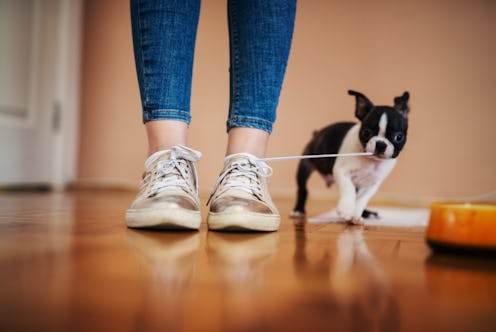Life
Here's How To Get Your Dog To Stop Chewing Up Your House, According To Experts

If you want to get your dog to stop chewing everything in your house, that's entirely understandable. It's not fun to come home to half-eaten shoes, or to find them happily gnawing on the leg of your new sofa. But you will want to keep in mind, as you help your dog break this habit, that chewing is something they want and pretty much need to do.
"Dogs are hardwired to chew," Nicole Ellis, a certified professional dog trainer and pet lifestyle expert with Rover, tells Bustle. "They process a lot of information about the world around them with their mouths." So it's not so much about getting them to stop chewing, as it is about getting them to chew the right things.
"It’s normal and natural for a dog to want to chew things up, and giving them a safe outlet [...] is important," Ellis says. "But when your dog starts chewing household items, like clothing, it can turn into a problem pretty quickly." If that's the case, start by assessing the situation and figuring out why your dog is ripping things up. If they spend time alone while you're at work, for example, they're likely bored and looking for a way to pass the the time.
"What a bored dog needs is a job to do while you’re away," Ellis says. "Leaving your best friend with stuffed puzzle toys, DIY enrichment objects (i.e., holes punched in a plastic bottle filled with kibble or treats), or goodies hidden for an old-fashioned treasure hunt [...] can go a long way towards alleviating boredom."
If your dog is a puppy, this may simply be a stage they need to grow out of. "Dogs go through a chewing phase from three to six months, and it can last all the way up until eight months," Don Cherry, certified dog trainer and founder of Crafty Canine Club, a full-service training and boarding facility, tells Bustle. "If your dog begins to chew in this timeframe, it is most likely because they want to explore with their new adult teeth growing in."
No matter their age, though, it can help to give your dog plenty of physical activity and mental stimulation, Ellis says, which means going on walks together, playing with toys, letting them socialize with other dogs, and playing training games as a way to use up all their energy. That way they won't be inclined to wreck all your stuff in an effort to have fun.
It's also good to teach the difference between a shoe, a toy, and a table leg. "With careful observation and consistent redirection, dogs will learn what's OK and what's not," Tim Steele, CTC, a certified dog trainer and owner of Behavior Matters Academy, LLC, tells Bustle. "I don't punish them for chewing something — that will only teach them that it's not safe to chew that thing while you are there and they'll simply chew it when you leave. Instead, I focus on teaching a preferred behavior (in this case, what I do approve of for the dog to chew)." Just hand them a bone, and get their attention on that, instead.
One last tip is the "leave it" command, which you can use if your dog is eyeballing an item you don't want them to have. "If they begin to chew items they should not be," Cherry says, "correct them by saying 'leave it!' and when they release or drop the item, positively reinforce them by saying 'yes, good boy/girl!'"
Throughout the process, try not to leave items lying around that they can't chew, since you never know what'll be enticing. "While you're away, keep them in a dog-proof space and provide them with toys," Ellis says. "Crate training can also be a foolproof way to ensure your dog won't chew while you're out of the house. Management is key [as is reducing] access to items the dog wants to chew." With time and practice, your dog will learn what they're allowed to chew, and what they need to leave alone.
This article was originally published on